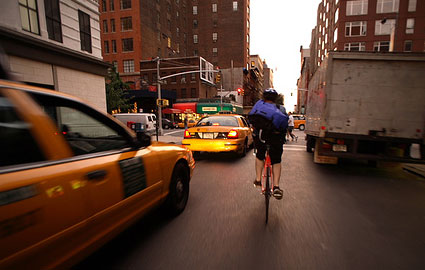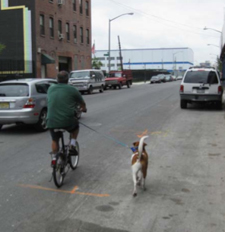
Protesters showed up in clown suits. Their opponents threatened to barricade a major thoroughfare with school buses. A respected community board member was fired from her leadership post. The debate has involved lost jobs, injury -- and even sex.
The source of all this controversy and activism? A bike lane.
With concerns about pollution, congestion and energy consumption, encouraging people to cycle instead of drive could be seen as a kind of motherhood and apple pie issue. But as the Department of Transportation greatly expands New York's bicycling lanes, it has encountered opposition from local small manufacturing businesses, the Hasidic community and shop owners, among others.
"We would never have predicted that bike lanes could provoke so much upset," Gowanus Lounge once observed after a community meeting on bike lanes, adding that a member of a local civic group said the issue "led to the most contentious meetings they have experienced, including discussions of Atlantic Yards."
Some of the controversy undoubtedly stems from the frenzied competition for New York's streets with motorists, cyclists, trucks, pedestrians, skaters and baby strollers all jostling up against each other for safe passage. Some critics, though, say the city, in its drive to expand bicycling, has not always consulted sufficiently with the affected communities .
Birth of a Bike Lane
The fight over the bike lane on Kent Avenue in Williamsburg has proved particularly contentious and shows no signs of abating.

Like many thoroughfares near the waterfront in the outer boroughs, Kent Avenue can feel like a desolate concrete valley. Big trucks gun their engines as they make their way to and from downtown Brooklyn, creating a noisy, dusty and dangerous situation for pedestrians and cyclists.
Mayor Michael Bloomberg's administration has sought to change that, and transform the area, along with other parts of the city's waterfront, into a vibrant ribbon of accessible open space and new high-rises. To achieve this, the administration sought to rezone the neighborhood in 2005. When elected representatives and residents balked at high-rises along the waterfront, the city offered three major incentives: open space with access to the river, affordable housing and retention the manufacturing jobs that have long sustained the neighborhood's working-class population. The rezoning was approved, and two years later, the city added the bike lane to the mix
In April 2008, Department of Transportation officials appeared before Community Board 1 to present the local segment of a greenway that would eventually stretch from Sunset Park in the south all the way to Greenpoint. Their drawings showed both lanes of bike traffic together, separated from cars and trucks by a planted divider. Until funds were available to build that, the transportation department representatives said, Kent Avenue needed a temporary bike lane because the street was dangerous without one.
That temporary design would involve a bike path along Kent, from Clymer Street to Quay Street. It would eliminate about 500 parking spaces, but the officials said parking on side streets and at new developments on the waterfront would replace them. These private buildings, when complete, would provide about 3,500 new parking spaces.
Originally, many residents were excited about safe bike routes along the river. In April, the community board voted 39 to 2 in favor of the long-term plan. But when the bike lanes were finally painted, problems appeared almost instantly. The lanes did not look like the ones in the pictures. They ran along both sides of the street, surprising even cyclists. And the signs that accompanied them did not just forbid parking, but all stopping at any time. Hasidic Jews charged the city first posted the laws banning parking on Kent at 6:30 a.m. on Saturday, when observant Jews are forbidden to drive and that traffic agent ticketed their cars.
Block the Dock
Businesses charged that the new bike paths prevented them from legally using their loading docks. David Hollier owns a high-end furniture shop that employs 10 people, most of whom, like Hollier, bike to work. The business requires Hollier to load and unload heavy pallets of fine wood almost every day. He does not see why he should lose access to his loading dock because of the bike lanes.
About 20 businesses on Kent raise similar concerns, including the glass producer Goldray Industries and Acme Smoked Fish.
The business owners say they were surprised by the new signs forbidding stopping in the bike lanes adjoining their loading docks. "They didn't even put a flyer on the door," Hollier said.
Karen Nieves, business services manager for the Greenpoint Williamsburg Industrial Business Zone, said she is "deeply disappointed in the lack of outreach for this plan." She thinks it could threaten the very survival of some of the manufacturers, all of whom together employ about 300 people.
The Department of Transportation insists it did all the outreach required when it addressed the Community Board on three separate occasions. If any groups didn't know enough about what has been going on the past two years," said Teresa Toro, who headed the Community Board's Transportation Committee until she was ousted late last year, "they should reach out to their representatives on CB1 and ask why they haven't kept you properly informed."
Living on the Lanes
The residents offer a different set of concerns. Most are Hasidic Jews and Latinos who live in "affordable" apartments set aside in new high-rise buildings. Since the area is not well served by public transit, many families rely on cars, and the parking spaces in the basements of their buildings are beyond their means at about $325a month. Now, residents complain, street parking is hard to find, and the ban on stopping in the bike lans means they cannot drop off or pick up family members anywhere near their homes.
The residents, like the business owners, say they did not receive adequate warning about the full effects of the bike path. At a Nov. 24 town hall meeting on transportation issues, Hasidic members of the Community Board said even they had not understood what was coming. Isaac Abraham, a Hasidic activist running for City Council, reminded representatives of the Department of Transportation that he helped organize a blockade of the New York marathon 20 years ago to protest a temporary closure of the Brooklyn Queens Expressway. If the lost parking spaces were not restored, he said, he might consider a similar move, blocking Kent Avenue with school buses.
Reaching a Compromise?
So far, the bike lanes remain. At a community board meeting in January, bike lane supporters showed up in force. City officials have not shown any public sign of wavering, although the Department of Transportation's borough commissioner, Joseph Palmieri, has tweaked the plan a bit. The department now allows bus pickup in front of the Zafir Jewish Learning Center. It temporarily eased up on issuing tickets for blocking the bike lanes and installed a loading dock for one manufacturer, Carriage House Papers. The owner of Carriage House, though, said the loading dock is useless because she has to circle the block to use it.
Meanwhile, discussions continue. A number of local leaders and politicians have written to the transportation department demanding the bike lane on the east side of the street be removed and parking restored. Councilmember David Yassky has put together a committee to consider alternative solutions, including the possibility, endorsed by some neighborhood activists, of making Kent Avenue into a one-way street.
Fueling the Opposition
Kent Avenue isn’t the only place where the city’s transportation planning has run up against the concerns of local business owners and residents. Wiley Norvell, communications director at the cyclist advocacy group Transportation Alternatives, sees people come out to fight nearly every mile of bike lane the city builds.
In Fort Greene, for instance, residents opposed five miles of lanes, marked by striped pavement, along Carlton and Willoughby streets in June 2006, and the community board voted against the plan 16 to 15. But the Department of Transportation went ahead and implemented the plan anyway, and few residents have complained since.
That case was typical, Norvell said, in that the opposition to the bike lanes was not so much about local issues but rather "a referendum on cycling as a form of transportation." About 80 percent of the negative comments about bike lanes, Norvell said, simply criticize bikers as jerks who don't follow the rules.
The lack of a true consultation process with affected commuities, though, makes the bike lanes a harder sell, Lower Manhattan offers another example of how the city's transportation planning can run up against the concerns of local business owners.
Last fall the Department of Transportation began installing a new bike lane on Grand Street between Varick Street and Chrystie Street through Soho, Little Italy and Chinatown. Presenting the bike lane as an important connection from the Manhattan and Williamsburg Bridges for commuters into Lower Manhattan, the department's plan consisted of an northern lane for commercial loading and unloading, a lane for motor traffic, a parking lane, a buffer and a bicycle lane along the southern curb. In July the proposal passed the board with a vote of 33 in favor, 1 against and 1 abstention.
Opposition from some business owners materialized, however, as the bike lane was installed. A few in the business community felt they had not been sufficiently consulted or educated about the changes.
The protected lane with the buffer between car and bicycle is intended to make bicyclists safer and keep the bike lane clear of double-parked cars and other vehicles. It also has narrowed the street, though, and some business owners contend this makes it more difficult for large tour buses to navigate. As a result, they say, fewer tourists have patronized their businesses.
Others dismiss any correlation between the bike lane and decreased businesses, attributing any falloff in customers to the declining economy rather than the bike lane. In a December op-ed article for the Villager, restaurateur and Soho resident Florent Morellet wrote the Grand Street bike lane creates a more orderly and a safer thoroughfare.
Transportation Alternatives’ Norvell agrees. "It is a much more orderly environment," he said. "I think overall the street configuration is in really good shape." Grand Street was remodeled from one and a half lanes of traffic, which led motorists to jockey for position, exacerbating congestion, to a single lane of motor vehicle traffic.
A bike messenger, though, was less enthusiastic about the lane. "It doesn't keep pedestrians out of the street. People see it as another place to walk," he said. On a recent afternoon postal workers and a deliveryman pushed carts through the lane.
Concerns raised earlier this winter over congestion and an overly street maybe easing. "I wouldn't worry about all that gossip," said a part-time worker at Ferrara Cafe. Concerns that the bike lane has made tourist access too difficult were played down. "This is a very well known place, known all over the world."
The current attitude on Grand Street seems to indicate that, in general, business owners, residents, and cyclists agree that bike lanes are a good thing for safety and for the environment. The problems many have is the way the city goes about implementing its policy to expand bike lanes.
"How are you going to make it 'no stopping at any time' and not let them know?" asked Nieves of the Greenpoint Williamsburg Industrial Business Zone. Taking consultation beyond the community boards and doing some more direct outreach might make for a far smoother ride.